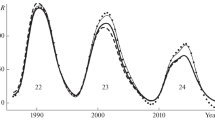Abstract
The effects of hysteresis, which is a manifestation of ambiguous relationships between different solar activity indices during the rising and declining phases of solar cycles, are analyzed. The paper addresses the indices characterizing radiation from the solar photosphere, chromosphere, and corona, and the ionospheric indices. The 21st, 22nd, and 23rd solar cycles, which significantly differ from each other in amplitude, exhibit different extents of hysteresis.
Similar content being viewed by others
References
Bachmann, K.T. and White, O.R., Observations of hysteresis in solar cycle variations among seven solar activity indicators, Sol. Phys., 1994, vol. 150, pp. 347–357.
Bruevich, E., Bruevich, V., and Yakunina, G., Changed relation between solar 10.7-cm radio flux and some activity indices which describe the radiation at different altitudes of atmosphere during cycles 21–23, J. Astrophys. Astron., 2014, vol. 35, pp. 1–15.
Bruevich, E.A. and Yakunina, G.V., General trends in the change in solar activity indices in the period from the late XX to early XXI century, Geomagn. Aeron. (Engl. Transl.), 2015, vol. 55, no. 8, pp. 1060–1065.
Ching, B.K. and Chiu, Y.T., A phenomenological model of global ionospheric electron density in the E-, F1- and F2-regions, J. Atmos. Terr. Phys., 1973, vol. 35, pp. 1615–1630.
Kazachevskaya, T.V. and Katyushina, V.V., Variations in the H Lya intensity in solar activity cycles from measurements onboard satellites and rockets, Phys. Chem. Earth, 2000, vol. 25, pp. 425–427.
Kitchatinov, L.L. and Olemskoy, S.V., Dynamo hysteresis and grand minima of solar activity, Astron. Lett., 2010, vol. 36, pp. 292–296.
Mikhailov, A.V. and Mikhailov, V.V., Hysteresis of F2 critical frequencies, Geomagn. Aeron. (Engl. Transl.), 1993, vol. 33, pp. 89–96.
NOAA NGDC space weather, solar indices data. http://www.ngdc.noaa.gov/stp/space-weather/solar-data/solar-indices.2013.
Nusinov, A.A. and Katyushina, V.V., Lyman-alpha line intensity as a solar activity index in the far ultraviolet range, Sol. Phys., 1994, vol. 152, pp. 201–206.
Nusinov, A.A., Hysteresis of a solar EUV flux and the relation of its characteristics to the solar cycle amplitude, Radiophys. Quantum Electron., 1996, vol. 39, pp. 830–832.
Pipin, V.V. and Kosovichev, A.G., Effects of large-scale non-axisymmetric perturbations in mean-field solar dynamo, Astrophys. J., 2015, vol. 813, no. 2, id 134.
Watanabe, K. and Hinteregger, H.E., Photoionization rates in the E and F regions, J. Geophys. Res., 1962, vol. 67, pp. 999–1006.
Author information
Authors and Affiliations
Corresponding author
Rights and permissions
About this article
Cite this article
Bruevich, E.A., Kazachevskaya, T.V., Katyushina, V.V. et al. Hysteresis of indices of solar and ionospheric activity during 11-year cycles. Geomagn. Aeron. 56, 1075–1081 (2016). https://doi.org/10.1134/S001679321608003X
Received:
Accepted:
Published:
Issue Date:
DOI: https://doi.org/10.1134/S001679321608003X




